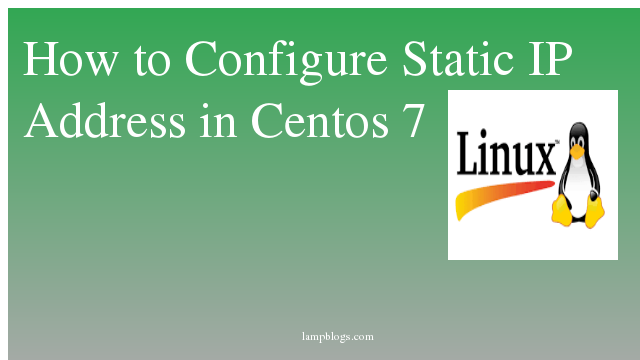

Hit edit.Ĭonfiguring a static IP in Ubuntu 14.04, 16.04 Press ‘Tab’ key to navigate to the other options.
#CENTOS 7 STATIC IP INSTALL#
It can be installed both on RPM and Debian based distributions.įor Centos & RHEL 7 yum install NetworkManager-tui dnf install NetworkManager-tui For Fedora 21 and later Nmtui, short for Network Manager Text User interface is a GUI tool that painlessly allows you to configure your network interface without having to touch the command line. Restart the networking service systemctl restart networkĪlso, check the nameservers cat /etc/nf To set a static IP, modify the following settings: HWADDR=08:00:27:1d:2a:e1 This tells the system to start networking service at boot time. The sample output should contain the following parameters: NETWORKING=yes Navigate to the following path to view interface statistics of interface enp0s3 vi /etc/sysconfig/network-scripts/ifcfg-enp0s3 TX errors 0 dropped 0 overruns 0 carrier 0 collisions 0Ībove, we can observe that our IP address is 192.168.43.160 and netmask is 255.255.255.0 We are going to configure this statically. Configuring a static IP in Fedora 27, CentOS and RHEL 7įirstly, list the IP of all interfaces ifconfig -a Let’s see how we can configure a static IP in different distros. This will definitely cause loss of service once the IP changes. You definitely don’t want its IP to keep changing once the DHCP lease time is over. A good example is where you have a server, e.g a web server or an FTP server. However, there are certain instances that require configuration of a static IP. This implies that it automatically obtains an IP address from a router or a DHCP server in a network. PEERDNS=no (then add DNS to /etc/resolv.By default, upon installation, any Linux system uses DHCP for its network configuration. The above two methods can be applied similarly to a static IP address case. So there is no need to modify /etc/nf yourself. The DNS servers specified with DNS1/DNS2 directives will then automatically be added to /etc/nf when the interface is activated. That is: $ sudo vi /etc/sysconfig/network-scripts/ifcfg-eth0

$ sudo vi /etc/nfĪlternatively, you can specify DNS servers directly in the interface configuration file, instead of modifying /etc/nf yourself. $ sudo vi /etc/sysconfig/network-scripts/ifcfg-eth0 The configuration file for your network interface (e.g., eth0) looks like the following. So instead of using DHCP-provided DNS, you can specify any arbitrary DNS servers you want to use in /etc/nf. This option will prevent /etc/nf from being modified by a DHCP server. In this case, there are actually two ways to do it. If you disabled Network Manager, but use network service instead, you can use interface configuration files (e.g., /etc/sysconfig/network-scripts/ifcfg-eth0) to specify static DNS. Configure Static DNS in /etc/sysconfig/network-scripts/ifcfg. If you use a static IP address, simply enter your DNS servers in the DNS servers field. Then in the DNS servers field, enter a comma separate list of DNS servers to use (e.g., 8.8.8.8 and 8.8.4.4). In case of DHCP, choose Automatic (DHCP) addresses only method, so that your DHCP server cannot override your DNS setting. If you are using Network Manager, you can configure static DNS as follows. Configure Static DNS with Network Manager On RHEL based systems, Network Manager is used to manage network interfaces by default, while you can always switch to network service. If you want to hard-code DNS servers to use on CentOS or Fedora, the method can differ, depending on whether you use Network Manager or network service. In general, how can I configure DNS servers statically on CentOS or Fedora? However, I want to use public DNS servers (e.g., Google DNS), not those assigned by a DHCP server. Question: On CentOS, I am getting an IP address assigned by DHCP.


 0 kommentar(er)
0 kommentar(er)
